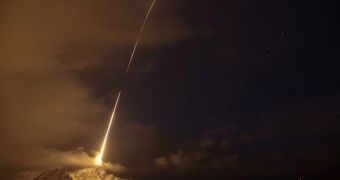A few days ago, a rocket carrying scientific instruments took off from the Arctic, hurtling into our planet's beautiful light displays called the aurora. The goal of the investigation was to gain more insight into the phenomenon that causes satellites in low-Earth orbit (LEO) to experience drag.
The launch took place on Sunday, December 12, from an island located within the Arctic Circle. The rocket took off from the Andøya Rocket Range, in Norway, but it belonged to NASA.
Experts say that the rocket took on an arching path, which took it through the auroras at high altitudes. Its science suite allowed it to collect and send back valuable data, before the delivery system plummeted to the Norwegian Sea.
It made contact with the water 10 minutes and 900 miles (1,450 kilometers) later. Throughout its mission, the onboard instruments continuously collected data of the northern lights, beaming them back to mission controllers on the ground.
Auroras are formed at the poles of most magnetically-active planets. In our solar system, Earth, Saturn and Jupiter are just the main example of space bodies capable of putting on a light show.
The phenomenon itself is produced as streams of electrically-charged particles emanating from the Sun slam into the atmosphere's protective shield, called the magnetosphere. As they do so, they are channeled along our planet's magnetic field lines.
This is what makes some auroras take on a curtain-like appearance, experts explain. The more intense the solar radiation is, the more luminous the amazing light show becomes, Space reports.
But the main point of the Rocket Experiment for Neutral Upwelling (RENU) study was determining why auroras create drag on satellites flying above it. This has been observed for some time now, but experts have yet to fully understand why.
The rocket, measuring 65 feet (19.8 meters), therefore collected measurements on traits of electric and magnetic fields, neutral gas, precipitating particles, as well as other characteristics of northern lights.
What's interesting about aurora-induced satellite drag is that it becomes very noticeable during periods in which the lights shine brighter than usual, Space reports. This hints at an unknown connection.
“This is the first time anyone has tried to measure these neutral particle enhancements at these altitudes and with this combination of instruments,” says University of New Hampshire associate professor and lead RENU investigator Marc Lessard.
“From NASA's point of view this is a mission of pure science. We're trying to understand the processes behind neutral upwelling and how it is associated with visible aurora phenomena,” he adds.
The expert concludes by saying that analyzing the volume of data collected during the flight could take months. When the investigation is complete, he and his team will publish the results in a scientific journal.

 14 DAY TRIAL //
14 DAY TRIAL //